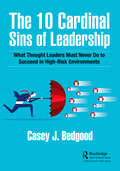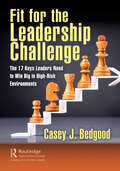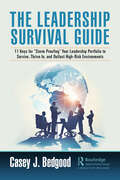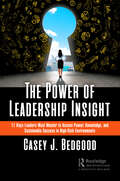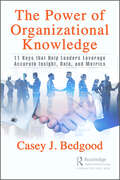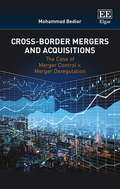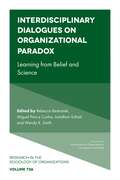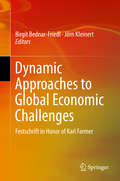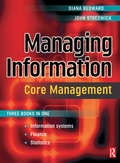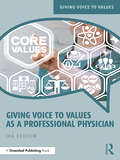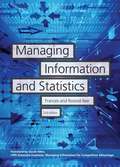- Table View
- List View
The 10 Cardinal Sins of Leadership: What Thought Leaders Must Never Do to Succeed in High-Risk Environments
by Casey J. BedgoodWhy do some leaders succeed and others fail? Is there a magic ingredient that the leaders must consider in their career journey to ensure the joy ride does not turn into a nightmare? What is the key to maximizing leaders' success in ways that are sustainable long term? The purpose of this book is to provide a simple road map for leaders, aspiring leaders, students, and anyone interested in the art of leadership to succeed in high-risk environments. Often, leaders don’t know what they don’t know. One main culprit is the lack of assessing, measuring, analyzing, and addressing risk. Simply put, we don’t know what we don’t measure. What is not known can and will eventually harm leaders, organizations, and their customers. Change is the new normal and only constant. As change grows, so does risk. Risk can be a friend or foe to thought leaders. It all depends on perspective, insight, and knowledge. Ignorance is never bliss, and leaders must leverage knowledge to mitigate risks at every turn. In The 10 Cardinal Sins of Leadership: What Thought Leaders Must Never Do to Succeed in High-Risk Environments, readers will learn: How to identify, measure, analyze, and address various types of risk How to determine if risk is a friend or a foe Strategic planning concepts that will allow leaders to magnify, plan for, leverage, and marginalize risks long term Methods to ensure that inclusion efforts do not become overly exclusive, thus excluding key stakeholders and creating new levels of organizational risk Techniques for looking back at organizational yesteryears to create a high-performing journey map for the road ahead The value of perspective – how we view things determines how we respond or wait to be disrupted unknowingly
The 10 Cardinal Sins of Leadership: What Thought Leaders Must Never Do to Succeed in High-Risk Environments
by Casey J. BedgoodWhy do some leaders succeed and others fail? Is there a magic ingredient that the leaders must consider in their career journey to ensure the joy ride does not turn into a nightmare? What is the key to maximizing leaders' success in ways that are sustainable long term? The purpose of this book is to provide a simple road map for leaders, aspiring leaders, students, and anyone interested in the art of leadership to succeed in high-risk environments. Often, leaders don’t know what they don’t know. One main culprit is the lack of assessing, measuring, analyzing, and addressing risk. Simply put, we don’t know what we don’t measure. What is not known can and will eventually harm leaders, organizations, and their customers. Change is the new normal and only constant. As change grows, so does risk. Risk can be a friend or foe to thought leaders. It all depends on perspective, insight, and knowledge. Ignorance is never bliss, and leaders must leverage knowledge to mitigate risks at every turn. In The 10 Cardinal Sins of Leadership: What Thought Leaders Must Never Do to Succeed in High-Risk Environments, readers will learn: How to identify, measure, analyze, and address various types of risk How to determine if risk is a friend or a foe Strategic planning concepts that will allow leaders to magnify, plan for, leverage, and marginalize risks long term Methods to ensure that inclusion efforts do not become overly exclusive, thus excluding key stakeholders and creating new levels of organizational risk Techniques for looking back at organizational yesteryears to create a high-performing journey map for the road ahead The value of perspective – how we view things determines how we respond or wait to be disrupted unknowingly
Fit for the Leadership Challenge: The 17 Keys Leaders Need to Win Big in High-Risk Environments
by Casey J. BedgoodThe key to effective leadership is being fit for the challenge. Leadership is a perpetual boxing match in many respects in which preparation, stamina and skill are required. Only the strongest survive. Every decision and tollgate along the career journey is laden with risk. Those leaders who harness risk to their advantage will land the knockout punch in every fight. The only question is how many leaders will be fit enough for the challenge? The purpose of this book is to provide insight as to how risk impacts every aspect of leadership, including the mundane, routine and nonglamorous aspects of leadership. This is important because often the small things can easily turn into big disruptors. Moreover, the end goal is to equip leaders with a journey map and quick guide to win in high-risk environments. Change is the new normal and only constant in today’s world. As change increases, so will risk and its subsequent impacts on humanity. This includes leaders, organizations and customers. No one is exempt. In this book, readers learn how to: Determine which career battles to fight and which ones to avoid Prepare to fight the unavoidable challenges along the career journey Leverage risk to choose the right leaders for the team Leverage risk to invest time wisely and avoid wasting it Leverage risk to predict, identify and resolve leadership burnout Risk assess leadership credentials so only those that produce a return are added to the portfolio Risk assess performance outcomes so the path ahead is smooth sailing instead of a rough ride Leverage risk so high performance is a reality instead of a pipe dream Leverage risk to find the right leadership sponsor
Fit for the Leadership Challenge: The 17 Keys Leaders Need to Win Big in High-Risk Environments
by Casey J. BedgoodThe key to effective leadership is being fit for the challenge. Leadership is a perpetual boxing match in many respects in which preparation, stamina and skill are required. Only the strongest survive. Every decision and tollgate along the career journey is laden with risk. Those leaders who harness risk to their advantage will land the knockout punch in every fight. The only question is how many leaders will be fit enough for the challenge? The purpose of this book is to provide insight as to how risk impacts every aspect of leadership, including the mundane, routine and nonglamorous aspects of leadership. This is important because often the small things can easily turn into big disruptors. Moreover, the end goal is to equip leaders with a journey map and quick guide to win in high-risk environments. Change is the new normal and only constant in today’s world. As change increases, so will risk and its subsequent impacts on humanity. This includes leaders, organizations and customers. No one is exempt. In this book, readers learn how to: Determine which career battles to fight and which ones to avoid Prepare to fight the unavoidable challenges along the career journey Leverage risk to choose the right leaders for the team Leverage risk to invest time wisely and avoid wasting it Leverage risk to predict, identify and resolve leadership burnout Risk assess leadership credentials so only those that produce a return are added to the portfolio Risk assess performance outcomes so the path ahead is smooth sailing instead of a rough ride Leverage risk so high performance is a reality instead of a pipe dream Leverage risk to find the right leadership sponsor
The Leadership Survival Guide: 11 Keys for "Storm Proofing" Your Leadership Portfolio to Survive, Thrive In, and Outlast High-Risk Environments
by Casey J. BedgoodCurrently, change is the new normal. As change grows, so does risk. But how will leaders understand the risk if they don’t measure it? In short, they won’t. The reality is that ignorance is never bliss. What leaders and their organizations don’t know will eventually impact them and their customers. Thus, situational awareness, forethought, and preparation are now key competencies for leaders to survive in high-risk environments. In this book, readers will learn the basics of leadership time management, the disruptability quotient, the leadership “canary” and why it’s just as important to leaders as it was to coal miners, and the slippery slope of change management (do we improve, change, or model the current state?), signals of leadership maturity and false positives, mastering the art of organizational knowledge, the pearls, and pitfalls of leadership rebranding, and the risk of non-utilized talent. Why aren’t current leaders required to undergo “storm proofing” from an operational perspective? As many of us experienced in various academic programs, the main foci are technical skills in management, organizational theory, data analysis, and many of the traditional leadership training courses. But, what happens when a leadership storm appears such as an unprecedented pandemic or supply chain crisis, or talent gaps where workers are not available to complete the basic services humanity relies on daily? Most leaders were not and are not prepared for today’s storms. The result is reactive leadership, higher-than-expected risk propositions, and disruptive transformations that force leaders from their perches to find the next best role their skillsets will buy. This book is for leaders and professionals who are currently, or will be leading teams, divisions, and organizations. Its purpose is to provide practical guidance on how leaders can “stormproof” their portfolios. Thus, they will be able to survive, thrive in, and outlast high-risk leadership storms that will overwhelm their less-prepared peers.
The Leadership Survival Guide: 11 Keys for "Storm Proofing" Your Leadership Portfolio to Survive, Thrive In, and Outlast High-Risk Environments
by Casey J. BedgoodCurrently, change is the new normal. As change grows, so does risk. But how will leaders understand the risk if they don’t measure it? In short, they won’t. The reality is that ignorance is never bliss. What leaders and their organizations don’t know will eventually impact them and their customers. Thus, situational awareness, forethought, and preparation are now key competencies for leaders to survive in high-risk environments. In this book, readers will learn the basics of leadership time management, the disruptability quotient, the leadership “canary” and why it’s just as important to leaders as it was to coal miners, and the slippery slope of change management (do we improve, change, or model the current state?), signals of leadership maturity and false positives, mastering the art of organizational knowledge, the pearls, and pitfalls of leadership rebranding, and the risk of non-utilized talent. Why aren’t current leaders required to undergo “storm proofing” from an operational perspective? As many of us experienced in various academic programs, the main foci are technical skills in management, organizational theory, data analysis, and many of the traditional leadership training courses. But, what happens when a leadership storm appears such as an unprecedented pandemic or supply chain crisis, or talent gaps where workers are not available to complete the basic services humanity relies on daily? Most leaders were not and are not prepared for today’s storms. The result is reactive leadership, higher-than-expected risk propositions, and disruptive transformations that force leaders from their perches to find the next best role their skillsets will buy. This book is for leaders and professionals who are currently, or will be leading teams, divisions, and organizations. Its purpose is to provide practical guidance on how leaders can “stormproof” their portfolios. Thus, they will be able to survive, thrive in, and outlast high-risk leadership storms that will overwhelm their less-prepared peers.
The Power of Leadership Insight: 11 Keys Leaders Must Master to Access Power, Knowledge, and Sustainable Success in High-Risk Environments
by Casey J. BedgoodLeadership is a risky business. In the current world, change is the new normal and only constant. As change grows, so does risk. Thus, leaders must be master change agents and master mitigators of risk. But, how will leaders succeed if they don’t measure and lack insight? Simply put, they won’t. Those that are successful in these arenas will ride the waves of success during their tenure on the leadership stage. In contrast, their counterparts will be crushed by the never-ending waves of disruption. Often leaders or those aspiring erroneously view leadership power from a self-interested perspective. They see power through the lens of a title, position, control over others, influence, emotional intelligence and the like. Unfortunately, this view is misaligned and short sighted. Another perspective of leadership is the ability to impact positive change for those around you. In reality, leaders are those that use their gifts, skills and knowledge to educate and empower others in the long run. The purpose of this book is to unveil insight as to the true meaning of leadership power – how to attain it, how to leverage it to add the greatest amount of value to humanity, how to weaponize it to marginalize and eliminate risk and how to share it with others so they can carry the torch once you step off the leadership stage. In this book, readers will learn: How to master the art of change The value of leadership self-advocacy The pearls and pitfalls of leading integration teams The unintended consequences of sharing knowledge The sidewinder effect of misinterpreting root causes of success The leadership test of humility Leadership matchmaking to ensure the right leaders are selected to solve the organization’s problems Leadership Loopholes: The Houdini Effect The risk of underestimating leadership value The risk of not focusing on the right attributes The risk of leading turnarounds
The Power of Leadership Insight: 11 Keys Leaders Must Master to Access Power, Knowledge, and Sustainable Success in High-Risk Environments
by Casey J. BedgoodLeadership is a risky business. In the current world, change is the new normal and only constant. As change grows, so does risk. Thus, leaders must be master change agents and master mitigators of risk. But, how will leaders succeed if they don’t measure and lack insight? Simply put, they won’t. Those that are successful in these arenas will ride the waves of success during their tenure on the leadership stage. In contrast, their counterparts will be crushed by the never-ending waves of disruption. Often leaders or those aspiring erroneously view leadership power from a self-interested perspective. They see power through the lens of a title, position, control over others, influence, emotional intelligence and the like. Unfortunately, this view is misaligned and short sighted. Another perspective of leadership is the ability to impact positive change for those around you. In reality, leaders are those that use their gifts, skills and knowledge to educate and empower others in the long run. The purpose of this book is to unveil insight as to the true meaning of leadership power – how to attain it, how to leverage it to add the greatest amount of value to humanity, how to weaponize it to marginalize and eliminate risk and how to share it with others so they can carry the torch once you step off the leadership stage. In this book, readers will learn: How to master the art of change The value of leadership self-advocacy The pearls and pitfalls of leading integration teams The unintended consequences of sharing knowledge The sidewinder effect of misinterpreting root causes of success The leadership test of humility Leadership matchmaking to ensure the right leaders are selected to solve the organization’s problems Leadership Loopholes: The Houdini Effect The risk of underestimating leadership value The risk of not focusing on the right attributes The risk of leading turnarounds
The Power of Organizational Knowledge: 11 Keys that Help Leaders Leverage Accurate Insight, Data, and Metrics
by Casey J. BedgoodIs knowledge powerful? Do leaders and those aspiring really understand the importance and power of organizational knowledge? Can knowing accelerate one’s career journey, while not knowing disrupt success? Will leaders and organizations achieve their full potential and mission without leveraging organizational knowledge? This book is for leaders, aspiring leaders, professionals, students, performance improvement practitioners, and strategists regardless of industry. It provides a quick, clear, and concise guide for readers to understand organizational knowledge, create knowledge transfer plans, and leverage knowledge to lead from the front. Without knowledge, leaders and their organizations will eventually operationally perish. In this book, leaders will learn the power of the following: • Strategic knowledge• Knowledge related to organizational governance and structure• Creating knowledge plans and capturing and sharing knowledge• Leveraging organizational knowledge in integrating organizations and building teams• Knowledge in leadership decision making
The Power of Organizational Knowledge: 11 Keys that Help Leaders Leverage Accurate Insight, Data, and Metrics
by Casey J. BedgoodIs knowledge powerful? Do leaders and those aspiring really understand the importance and power of organizational knowledge? Can knowing accelerate one’s career journey, while not knowing disrupt success? Will leaders and organizations achieve their full potential and mission without leveraging organizational knowledge? This book is for leaders, aspiring leaders, professionals, students, performance improvement practitioners, and strategists regardless of industry. It provides a quick, clear, and concise guide for readers to understand organizational knowledge, create knowledge transfer plans, and leverage knowledge to lead from the front. Without knowledge, leaders and their organizations will eventually operationally perish. In this book, leaders will learn the power of the following: • Strategic knowledge• Knowledge related to organizational governance and structure• Creating knowledge plans and capturing and sharing knowledge• Leveraging organizational knowledge in integrating organizations and building teams• Knowledge in leadership decision making
English Language in India: A Dichotomy between Economic Growth and Inclusive Growth
by Jaskiran BediThis book examines the relationship between the English language and growth – economic and inclusive – in India. It explores why English continues to be the language of aspiration long after Independence. With the second largest English-speaking population in the world today, India is testimonial to how a linguistic legacy continues to cast a long shadow on its contemporary discourse in the economic arena. The volume: Explores how English language proficiency constitutes as human capital. Draws in the latest India Human Development Survey data. Investigates the relationship between the language and economic indicators such as wages, household income and state growth. Purther investigates the role of English language in the inclusivity of growth. Provides a snapshot of the pedagogy of English in the Indian education system. First of its kind in scope, this volume will be of great interest to scholars of economics, education, sociolinguistics, development studies, politics and sociology. It will also be of great interest to the general reader.
English Language in India: A Dichotomy between Economic Growth and Inclusive Growth
by Jaskiran BediThis book examines the relationship between the English language and growth – economic and inclusive – in India. It explores why English continues to be the language of aspiration long after Independence. With the second largest English-speaking population in the world today, India is testimonial to how a linguistic legacy continues to cast a long shadow on its contemporary discourse in the economic arena. The volume: Explores how English language proficiency constitutes as human capital. Draws in the latest India Human Development Survey data. Investigates the relationship between the language and economic indicators such as wages, household income and state growth. Purther investigates the role of English language in the inclusivity of growth. Provides a snapshot of the pedagogy of English in the Indian education system. First of its kind in scope, this volume will be of great interest to scholars of economics, education, sociolinguistics, development studies, politics and sociology. It will also be of great interest to the general reader.
Cross-Border Mergers and Acquisitions: The Case of Merger Control v. Merger Deregulation
by Mohammad BedierThis book demystifies the dynamics of cross-border mergers and acquisitions; from the preliminary agreements and due diligence, to valuation, structuring, financing, and the eventual closing of the deal. It examines merger incentives and efficiencies, in theory and in empirical findings. The author adeptly identifies the impediments facing cross-border mergers and acquisitions and focuses on pre-merger control laws and regulations, particularly those of the US, EU, and Middle East. Consideration is also given to merger deregulation and other key reforming proposals. The book will be a useful resource for students and scholars with an interest in mergers and acquisitions, antitrust laws, and corporate history. Legal Professionals and those in related fields will gain a practical understanding of how to tailor their deals to overcome the unique impediments associated with cross-border transactions. Policy makers will also find the information and assessment criteria developed in the book to be a useful tool for evaluating and designing policy.
Fiscal Policy in the Southern European Union Countries: The Aftermath of COVID-19 (Contributions to Finance and Accounting)
by Milan BednářThis book examines public debt hoarding within the Euro Area, which is one of the most complicated challenges regarding modern fiscal policy-making. The author offers an up-to-date analysis of the fiscal situations of Italy, Spain, Portugal, and Greece. The book describes key mechanisms of debt transmission, discusses the potential establishment of fiscal and debt union in the EU, identifies numerous implications, and connects the fiscal positions of the examined countries with the structural flaws of the Euro Area and the monetary policy of the European Central Bank. Moreover, the work presents an estimation of structural budget balances, including a comparison with the estimates of major international institutions such as the IMF, OECD, and European Commission. A separate chapter is devoted to analysing the fiscal policy determinants, using time series since the late 19th century, and the issue of fiscal policy efficiency. Finally, the work provides an overview of debt resolution options. Overall, this book offers eight core chapters intended for the public, professional economists, and policymakers.
Der Einfluss des Kundenverhaltens auf die Kundenzufriedenheit: Eine Untersuchung des Kundenkontakts aus der Anforderungen-Ressourcen Perspektive (Neue Perspektiven der marktorientierten Unternehmensführung)
by Marei BednarekDa der Erfolg von Unternehmen maßgeblich von der Zufriedenheit der Kunden abhängt, ist es besonders wichtig, alle Möglichkeiten zur Steigerung der Kundenzufriedenheit zu kennen und in Entscheidungsprozesse einbeziehen zu können. Marei Bednarek untersucht basierend auf dem Anforderungen-Ressourcen Modell den Einfluss, den Kunden selbst – durch ihr Verhalten in der persönlichen Interaktion mit Mitarbeitern – auf ihre Zufriedenheit haben können. Mithilfe dyadischer Daten von Kundenkontaktmitarbeitern und Kunden zeigt sie im Rahmen zweier empirischer Studien, dass negatives wie positives Kundenverhalten die Kundenorientierung sowie das kontraproduktive Verhalten von Mitarbeitern bedingt und darüber die Kundenzufriedenheit beeinflusst.
Interdisciplinary Dialogues on Organizational Paradox: Investigating Social Structures and Human Expression (Research in the Sociology of Organizations #73, Part B)
by Rebecca Bednarek Miguel Pina E Cunha Jonathan Schad Wendy K. SmithInterdisciplinary Dialogues on Organizational Paradox is a two-part volume exploring how paradox theory benefits from interdisciplinary theorizing and how we might go about undertaking such research. The chapters draw from four disciplinary realms: beliefs, physicality, expression, and social structure. Unique commentaries from thought leaders expand and assess the focal pieces of each volume. Part B: Investigating Social Structures and Human Expression continues the exploration of the why, how and where of interdisciplinary research within paradox theory by looking specifically at the realms of social structure - from logic and Luhmann, to historical analysis - and expression - from linguistics, to the maths and poetry of Spencer-Brown, to jazz. The chapters are complemented with reflective commentaries from Charles Hampden-Turner and Ann Langley. The collection ends with an examination of where the interdisciplinary foundations for organizational paradox theory arose via conversations with seminal paradox scholars.
Interdisciplinary Dialogues on Organizational Paradox: Learning from Belief and Science (Research in the Sociology of Organizations #73, Part A)
by Rebecca Bednarek Miguel Pina E Cunha Jonathan Schad Wendy K. SmithInterdisciplinary Dialogues on Organizational Paradox is an innovative two-part volume that enriches our understanding about paradox; both deepening the theory and offering greater insight to address the grand challenges we face in the world today. Authors demonstrate how paradox theory benefits from interdisciplinary theorizing by reaching out to disciplines beyond organizational theory and exploring best practice in undertaking such research. The 13 chapters in this double volume draw from four disciplinary realms: beliefs, physicality, expression, and social structure. Unique commentaries from thought leaders expand and assess the focal pieces of each volume. Part A: Learning from Belief and Science, explores the realms of beliefs - from Ubuntu, Ying-Yang, Christian and Islamic philosophies - and physicality - from quantum mechanics, technology, to ecology - with reflective commentaries from Jean M. Bartunek and Mary Frohlich, and Andrew Van de Ven.
Dynamic Approaches to Global Economic Challenges: Festschrift in Honor of Karl Farmer
by Birgit Bednar-Friedl Jörn KleinertThis book addresses three big economic challenges from a dynamic perspective: European integration, economic growth, and global climate change. In the light of the recent crises of the European Union (EU), the first part of the book deals with challenges to the real, monetary and fiscal integration of the EU and required institutional adjustments. The second part of the book addresses fundamental challenges of advanced market economies like economic growth and changes of technologies. The final part focuses on the global challenge of climate change from an economic perspective and discusses policy strategies for a successful mitigation of climate change.
Strategizing in the Polish Furniture Industry (Elements in Business Strategy)
by null Paulina Bednarz-ŁuczewskaThe Element provides a broad overview of the Polish furniture industry. It tells the story of a sector that grew from a bundle of craftsmen into Europe's largest and the world's second-largest furniture exporter within three decades. This is also the story of a sector marked by a subordinate role in global value chains and a mediocre ranking in the global value capture game. Equipped with the methods of anthropology and the theoretical lenses of strategic management, the author guides the reader through the living world of the sector's strategists – their environment, resources, and dilemmas. The Element reconstructs how the strategists engage in creative dialogue with factors at the macro level (semi-peripheral economy, global value chain position), meso level (human capital, governmental programs) and micro level (family traditions, personal interests) to create their unique business models.
Managing Information: Core Management
by Diana Bedward John StredwickThe authors focus on the following topics:Information Systems*Contribution of IS/IT to organisations*Systems concepts and attributes*Planning, reviewing and controlling with IS*Serving the end user - spreadsheets, databases, e-mail and DTP*Software application for HR and other areas*Legislation and SecurityFinance*Sources and application of funds*Accounting documentation - cash statements, profit and loss accounts, balance sheets*Interpretation of accounts - management ratios*Costing and budgetingStatistics*Sources and uses of statistics*Presentation of statistics*Interpretation - measures of average, measures of distribution, correlation, time series, index numbers, significance tests*Use of current software for computation of statistics
Managing Information: Core Management
by Diana Bedward John StredwickThe authors focus on the following topics:Information Systems*Contribution of IS/IT to organisations*Systems concepts and attributes*Planning, reviewing and controlling with IS*Serving the end user - spreadsheets, databases, e-mail and DTP*Software application for HR and other areas*Legislation and SecurityFinance*Sources and application of funds*Accounting documentation - cash statements, profit and loss accounts, balance sheets*Interpretation of accounts - management ratios*Costing and budgetingStatistics*Sources and uses of statistics*Presentation of statistics*Interpretation - measures of average, measures of distribution, correlation, time series, index numbers, significance tests*Use of current software for computation of statistics
Giving Voice to Values as a Professional Physician: An Introduction to Medical Ethics (Giving Voice to Values)
by Ira BedzowGiving Voice to Values as a Professional Physician provides students with the theoretical background and practical applications for acting on their values in situations of ethical conflict. It is the first medical ethics book that utilizes the Giving Voice to Values methodology to instruct students in medical ethics and professionalism. In doing so, it shifts the focus of ethics education from intellectually examining ethical theories and conflicts to emphasizing moral action. Each section of the book explains how moral decision-making and action can be implemented in the healthcare arena. Medical ethics cases are provided throughout in order to assist students in giving voice to their values and developing skills for professional action. The Giving Voice to Values methodology, and the cases in this book, do not focus on the big questions of academic ethics, but rather on the ethics of the everyday, even if the challenges presented are difficult. In other words, the ethical questions students will have to face, in this book and in medical education and practice, are about how to interact with others, whether they be patients or colleagues, who might have different ethical positions. The book provides a unique guide for professional identity formation and the teaching of ethics in medical schools.
Giving Voice to Values as a Professional Physician: An Introduction to Medical Ethics (Giving Voice to Values)
by Ira BedzowGiving Voice to Values as a Professional Physician provides students with the theoretical background and practical applications for acting on their values in situations of ethical conflict. It is the first medical ethics book that utilizes the Giving Voice to Values methodology to instruct students in medical ethics and professionalism. In doing so, it shifts the focus of ethics education from intellectually examining ethical theories and conflicts to emphasizing moral action. Each section of the book explains how moral decision-making and action can be implemented in the healthcare arena. Medical ethics cases are provided throughout in order to assist students in giving voice to their values and developing skills for professional action. The Giving Voice to Values methodology, and the cases in this book, do not focus on the big questions of academic ethics, but rather on the ethics of the everyday, even if the challenges presented are difficult. In other words, the ethical questions students will have to face, in this book and in medical education and practice, are about how to interact with others, whether they be patients or colleagues, who might have different ethical positions. The book provides a unique guide for professional identity formation and the teaching of ethics in medical schools.
Seasonal Adjustment Methods and Real Time Trend-Cycle Estimation (Statistics for Social and Behavioral Sciences)
by Estela Bee Dagum Silvia BianconciniThis book explores widely used seasonal adjustment methods and recent developments in real time trend-cycle estimation. It discusses in detail the properties and limitations of X12ARIMA, TRAMO-SEATS and STAMP - the main seasonal adjustment methods used by statistical agencies. Several real-world cases illustrate each method and real data examples can be followed throughout the text. The trend-cycle estimation is presented using nonparametric techniques based on moving averages, linear filters and reproducing kernel Hilbert spaces, taking recent advances into account. The book provides a systematical treatment of results that to date have been scattered throughout the literature. Seasonal adjustment and real time trend-cycle prediction play an essential part at all levels of activity in modern economies. They are used by governments to counteract cyclical recessions, by central banks to control inflation, by decision makers for better modeling and planning and by hospitals, manufacturers, builders, transportation, and consumers in general to decide on appropriate action. This book appeals to practitioners in government institutions, finance and business, macroeconomists, and other professionals who use economic data as well as academic researchers in time series analysis, seasonal adjustment methods, filtering and signal extraction. It is also useful for graduate and final-year undergraduate courses in econometrics and time series with a good understanding of linear regression and matrix algebra, as well as ARIMA modelling.
Managing Information and Statistics
by Roland Bee Frances BeeIn an age where organisations handle significant volumes of data on a daily basis, it is vital that effective information management systems are put in place to manage them and use them to their full potential. Managing Information and Statistics provides the information needed for a sound understanding of the concepts that underpin this key area that is now a feature of every aspect of organisational life. The first part deals with information systems generally, whilst the second looks at how numerical data can be used to develop strategy. Topics addressed include how to utilise information systems for planning and organisation, and storing data; how to design, develop and implement an information systems; data security and human resources information system; how to exploit statistics to sample, forecast and make informed decisions.Fully revised and restructured to cater for CIPD students taking the Managing Information for Competitive Advantage module, as part of the Leadership and Management standards, Managing Information and Statistics is also essential reading for HR and business practitioners looking to further their professional development and manage effectively, as well as students studying information management as part of wider HR and business degrees. This fully revised edition includes case studies, examples, chapter objectives, exercises, chapter conclusions and further reading suggestions to aid student learning, as well as new chapters on Knowledge Management and the E-organisation. With a strategic approach and accessible style, this is your step-by-step guide to developing, managing and utilising information and statistics in a business context.
